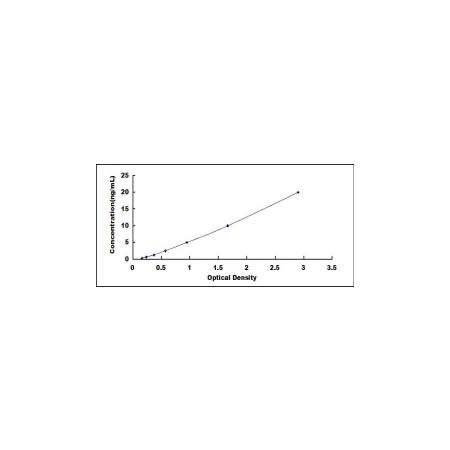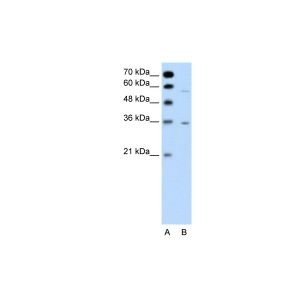GPRC5A ELISA Kit (Human)
Cat# OKCD02086
Size : 96Wells
Brand : Aviva Systems Biology
| Datasheets/Manuals | Printable datasheet for GPRC5A ELISA Kit (Human) (OKCD02086) |
|---|
| Predicted Species Reactivity | Homo sapiens|Human | ||||||||||||||||||||||
|---|---|---|---|---|---|---|---|---|---|---|---|---|---|---|---|---|---|---|---|---|---|---|---|
| Application | ELISA-Sandwich | ||||||||||||||||||||||
| ELISA Kit Detection Method | Colorimetric | ||||||||||||||||||||||
| ELISA Kit Duration | 3h | ||||||||||||||||||||||
| ELISA Kit Principle | The test principle applied in this kit is Sandwich enzyme immunoassay. The microtiter plate provided in this kit has been pre-coated with an antibody specific to G Protein Coupled Receptor, Family C, Group 5, Member A (GPRC5A). Standards or samples are then added to the appropriate microtiter plate wells with a biotin-conjugated antibody specific to G Protein Coupled Receptor, Family C, Group 5, Member A (GPRC5A). Next, Avidin conjugated to Horseradish Peroxidase (HRP) is added to each microplate well and incubated. After TMB substrate solution is added, only those wells that contain G Protein Coupled Receptor, Family C, Group 5, Member A (GPRC5A), biotin-conjugated antibody and enzyme-conjugated Avidin will exhibit a change in color. The enzyme-substrate reaction is terminated by the addition of sulphuric acid solution and the color change is measured spectrophotometrically at a wavelength of 450nm +/- 10nm. The concentration of G Protein Coupled Receptor, Family C, Group 5, Member A (GPRC5A) in the samples is then determined by comparing the O.D. of the samples to the standard curve. | ||||||||||||||||||||||
| ELISA Kit Range | 0.156-10ng/mL | ||||||||||||||||||||||
| ELISA Kit Reproducibility | Intra-assay Precision (Precision within an assay): 3 samples with low, middle and high level G Protein Coupled Receptor, Family C, Group 5, Member A (GPRC5A) were tested 20 times on one plate, respectively. Inter-assay Precision (Precision between assays): 3 samples with low, middle and high level G Protein Coupled Receptor, Family C, Group 5, Member A (GPRC5A) were tested on 3 different plates, 8 replicates in each plate. CV(%) = SD/meanX100 Intra-Assay: CV<10% Inter-Assay: CV<12% | ||||||||||||||||||||||
| ELISA Kit Component |
| ||||||||||||||||||||||
| Reconstitution and Storage | 2°C to 8°C|-20°C | ||||||||||||||||||||||
| Sample Type | Tissue homogenates, cell lysates and other biological fluids | ||||||||||||||||||||||
| Sensitivity | < 0.117 ng/mL | ||||||||||||||||||||||
| Specificity | This assay has high sensitivity and excellent specificity for detection of G Protein Coupled Receptor, Family C, Group 5, Member A (GPRC5A). No significant cross-reactivity or interference between G Protein Coupled Receptor, Family C, Group 5, Member A (GPRC5A) and analogues was observed. | ||||||||||||||||||||||
| Assay Info | Assay Methodology: Quantitative Sandwich Immunoassay |
| Gene Symbol | GPRC5A |
|---|---|
| Gene Full Name | G protein-coupled receptor class C group 5 member A |
| Alias Symbols | GPCR5A;G-protein coupled receptor family C group 5 member A;orphan G-protein-coupling receptor PEIG-1;PEIG-1;phorbol ester induced gene 1;phorbol ester induced protein-1;RAI3;RAIG1;retinoic acid induced 3;retinoic acid responsive;retinoic acid-induced gene 1 protein;retinoic acid-induced protein 3;TIG1;TPA induced gene 1. |
| NCBI Gene Id | 9052 |
| Protein Name | Retinoic acid-induced protein 3 |
| Description of Target | Orphan receptor. Could be involved in modulating differentiation and maintaining homeostasis of epithelial cells. This retinoic acid-inducible GPCR provide evidence for a possible interaction between retinoid and G-protein signaling pathways. Functions as a negative modulator of EGFR signaling (By similarity). May act as a lung tumor suppressor (PubMed:18000218). |
| Uniprot ID | Q8NFJ5 |
| Protein Accession # | NP_003970.1 |
| Nucleotide Accession # | NM_003979.3 |
| Protein Size (# AA) | 357 |





